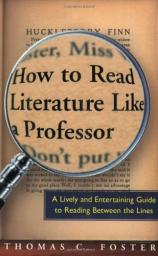How to Read Literature Like a Professor: A Lively and Entertaining Guide to Reading Between the Lines
Review
How to Read Literature Like a Professor: A Lively and Entertaining Guide to Reading Between the Lines
One thing's for certain: after finishing HOW TO READ LITERATURE
LIKE A PROFESSOR, you will either praise the author for opening
your eyes to the pleasures of literary analysis, or curse him for
making you think too much. That's because Thomas C. Foster, a
professor of English at the University of Michigan at Flint, gives
his readers a lot to consider.
The short answer one comes away with is that nothing is as it
appears to be. Symbolism is key. Weather, for example, is not just
weather. Rain can be cleansing, cold is harsh but clean, wet is
earthy and animal.
In case the reader doesn't quite get what Foster is saying, he
succinctly states his meaning in a single, boldface sentence. "Myth
is a body of the story that matters" reads one. "The real reason
for a quest is always self-knowledge" is another.
My favorite is, "There's no such thing as a wholly original work of
literature," a theme that is repeated on several occasions.
According to Foster, everything any author has ever read influences
what he writes. Using the western film as an example, he suggests,
"What's it about? A big showdown? High Noon. A gunslinger who
retires? Shane. A lonely outpost during an uprising? Fort Apache,
She Wore a Yellow Ribbon - the woods are full of them . . ." Not
that he blames writers for lack of originality: "You can't avoid
[repetition], since even avoidance is a form of interaction. It's
simply impossible to write . . . in a vacuum."
As previously mentioned, some chapters get slightly repetitive.
"It's More Than Just Rain or Snow" has many features similar to
"…And So Does Season," while "One Story" mirrors many aspects
of "Now, Where Have I Seen Her Before." That's okay, though; some
things bear repeating.
There's also a great deal of religious symbolism in literature.
"Whenever people eat or drink together, it's Communion," Foster
declares (again ensuring the reader gets the point). There are also
plenty of male and female "Christ figures" and chapters like "If
She Comes Up, Its Baptism" (i.e., emerging from the water equals
rebirth).
"Don't Read With Your Eyes," a telling chapter in an age where
certain people still seek to ban books, reminds us that present
sensibilities might not always apply to the realities in which the
story was written. Just look at all the uproar over THE ADVENTURES
OF HUCKLEBERRY FINN because some consider it politically incorrect.
In Mark Twain's time, however, that was how people lived, spoke and
felt.
With the first novel I tackled after HOW TO READ LITERATURE LIKE A
PROFESSOR, I found myself looking under the rug and in the corners
for meanings that may or may not exist. As the saying goes,
"Sometimes a cigar is just a smoke." One of the problems college
students encounter is the spiel their professors weave. "A moment
occurs in this exchange between professor and student when each of
us adopts a look," Foster explains. "My look says, 'What, you don't
get it?' Theirs says, 'We don't get it. And we think you're making
it up.'" But the author maintains that writers do consciously
render these symbols when plying their craft.
"Memory. Symbol. Pattern. These are the three items that, more than
any other, separate the professorial reader from the rest of the
crowd," he offers. Just how can us regular-Joe readers recognize
all these possibilities? "Same way you get to Carnegie Hall,"
Foster cracks. "Practice."
Reviewed by Ron Kaplan ([email protected]) on January 22, 2011
How to Read Literature Like a Professor: A Lively and Entertaining Guide to Reading Between the Lines
- Publication Date: March 1, 2003
- Genres: Literary Criticism, Nonfiction
- Paperback: 336 pages
- Publisher: Harper Paperbacks
- ISBN-10: 006000942X
- ISBN-13: 9780060009427










